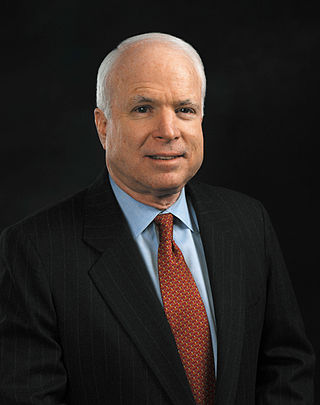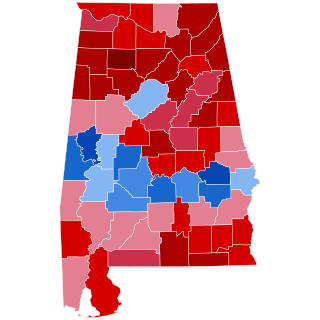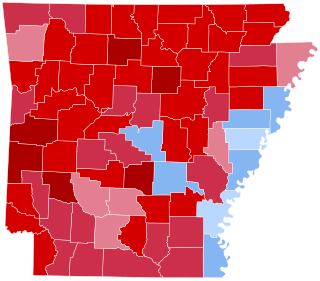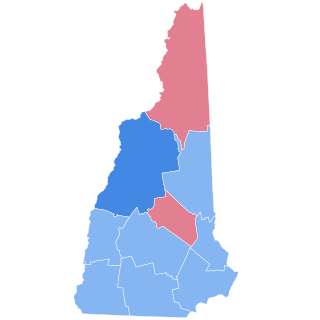
The New Hampshire presidential primary is the first in a series of nationwide party primary elections and the second party contest, the first being the Iowa caucuses, held in the United States every four years as part of the process of choosing the delegates to the Democratic and Republican national conventions which choose the party nominees for the presidential elections to be held in November. Although only a few delegates are chosen in the New Hampshire primary, its real importance comes from the massive media coverage it receives, along with the first caucus in Iowa.

The 1968 United States Senate elections were elections for the United States Senate. Held on November 5, the 34 seats of Class 3 were contested in regular elections. They coincided with the presidential election of the same year. The Republicans picked up five net seats in the Senate. This saw Republicans win a Senate seat in Florida for the first time since Reconstruction.

The 2008 United States presidential election in California took place on November 4, 2008, in California as part of the 2008 United States presidential election. Voters chose 55 electors, the most out of any of the 50 states, to the Electoral College, who voted for president and vice president.

The 2008 Oregon Republican presidential primary was a mail only primary in the U.S. state of Oregon. Ballots were mailed to registered Republican voters between May 2 and May 6, 2008. To be counted, all ballots must have been received by county elections offices by 8:00 p.m. PDT on May 20, 2008. It was a closed primary; in order to vote in Republican races, residents must have registered as Republicans on or before April 29, 2008.

The 2012 United States Senate election in Tennessee took place on November 6, 2012, as part of the general election including the 2012 U.S. presidential election, elections to the House of Representatives and various state and local elections. Incumbent Republican U.S. Senator Bob Corker won a second term in a landslide, carrying all but two counties in the state.

The 2012 United States presidential election in California took place on November 6, 2012, as part of the 2012 United States presidential election in which all 50 states plus the District of Columbia participated. California voters chose 55 electors, the most out of any state, to represent them in the Electoral College via a popular vote pitting incumbent Democratic President Barack Obama and his running mate, Vice President Joe Biden, against Republican challenger and former Massachusetts Governor Mitt Romney and his running mate, Congressman Paul Ryan.

The 1996 United States presidential election in New Hampshire took place on November 5, 1996, as part of the 1996 United States presidential election. Voters chose four representatives, or electors to the Electoral College, who voted for president and vice president.

The 2018 United States Senate elections were held on November 6, 2018. Among the 100 seats, the 33 of Class 1 were contested in regular elections while 2 others were contested in special elections due to Senate vacancies in Minnesota and Mississippi. The regular election winners were elected to 6-year terms running from January 3, 2019, to January 3, 2025. Senate Democrats had 26 seats up for election, while Senate Republicans had 9 seats up for election.

The 2020 United States Senate elections were held on November 3, 2020, with the 33 class 2 seats of the Senate contested in regular elections. Of these, 21 were held by Republicans, and 12 by Democrats. The winners were elected to 6-year terms from January 3, 2021, to January 3, 2027. Two special elections for seats held by Republicans were also held in conjunction with the general elections: one in Arizona, to fill the vacancy created by John McCain's death in 2018; and one in Georgia, following Johnny Isakson's resignation in 2019. These elections ran concurrently with the 2020 United States presidential election in which incumbent president Donald Trump lost to Democratic nominee Joe Biden.

Roque "Rocky" De La Fuente Guerra is an American businessman and politician. A perennial candidate, De La Fuente was the Reform Party nominee in the 2016 and 2020 United States presidential elections. He also appeared on his own American Delta Party's presidential ticket in 2016, and on those of the Alliance Party and American Independent Party in 2020.

The 2016 United States presidential election in California was held on Tuesday, November 8, 2016, as part of the 2016 United States presidential election in which all 50 states plus the District of Columbia participated. California voters chose electors to represent them in the Electoral College via a popular vote, pitting the Republican Party's nominee, businessman Donald Trump, and running mate Indiana Governor Mike Pence against Democratic Party nominee, former Secretary of State Hillary Clinton, and her running mate Virginia Senator Tim Kaine. California had 55 electoral votes in the Electoral College, the most of any state.

United States gubernatorial elections were held on November 8, 2022, in 36 states and three territories. As most governors serve four-year terms, the last regular gubernatorial elections for all but two of the seats took place in the 2018 U.S. gubernatorial elections. The gubernatorial elections took place concurrently with several other federal, state, and local elections, as part of the 2022 midterm elections.

The 2020 United States presidential election in Alabama took place on Tuesday, November 3, 2020, as part of the 2020 United States presidential election in which all 50 states and the District of Columbia participated. Alabama voters chose nine electors to represent them in the Electoral College via a popular vote pitting incumbent Republican President Donald Trump and his running mate, incumbent Vice President Mike Pence, against Democratic challenger and former Vice President Joe Biden and his running mate, United States Senator Kamala Harris of California. Also on the ballot was the Libertarian nominee, psychology lecturer Jo Jorgensen and her running mate, entrepreneur and podcaster Spike Cohen. Write-in candidates were permitted without registration, and their results were not individually counted.

The 2020 United States presidential election in Arkansas took place on Tuesday, November 3, 2020, as part of the 2020 United States presidential election in which all 50 states plus the District of Columbia participated. Arkansas voters chose six electors to represent them in the Electoral College via a popular vote pitting incumbent Republican President Donald Trump and his running mate, incumbent Vice President Mike Pence, against Democratic challenger and former Vice President Joe Biden and his running mate, United States Senator Kamala Harris of California. Also on the ballot were the nominees for the Libertarian, Green, Constitution, American Solidarity, Life and Liberty, and Socialism and Liberation parties and Independent candidates. Write-in candidates are not allowed to participate in presidential elections.

The 2020 United States presidential election in Oklahoma was held on Tuesday, November 3, 2020, as part of the 2020 United States presidential election in which all 50 states plus the District of Columbia participated. Oklahoma voters chose electors to represent them in the Electoral College via a popular vote, pitting the Republican Party's nominee, incumbent President Donald Trump, and running mate Vice President Mike Pence against Democratic Party nominee, former Vice President Joe Biden, and his running mate California Senator Kamala Harris. Oklahoma has seven electoral votes in the Electoral College.

The 2020 United States presidential election in New Hampshire was held on Tuesday, November 3, 2020, as part of the 2020 United States presidential election in which all 50 states and the District of Columbia participated. New Hampshire voters chose electors to represent them in the Electoral College via a popular vote, pitting the Republican Party's nominees, incumbent President Donald Trump and Vice President Mike Pence, against the Democratic Party's nominees, former Vice President Joe Biden and his running mate, Senator Kamala Harris. New Hampshire has four electoral votes in the Electoral College.

The Cook County, Illinois, general election was held on November 3, 2020. Elections were held for Clerk of the Circuit Court, State's Attorney, Cook County Board of Review district 1, three seats on the Water Reclamation District Board, and judgeships on the Circuit Court of Cook County.

Presidential primaries and caucuses are being organized by the Democratic Party to select the delegates to the 2024 Democratic National Convention, to determine the party's nominee for president in the 2024 United States presidential election. The elections will take place in most U.S. states, the District of Columbia, five U.S. territories, and Democrats Abroad, and will be held between January and June that year. Incumbent President Joe Biden is running for re-election with Vice President Kamala Harris returning as his running mate. On March 12, Biden secured enough delegates for re-nomination and was declared the presumptive nominee of the Democratic Party.

The 2024 United States presidential election in California is scheduled to take place on Tuesday, November 5, 2024, as part of the 2024 United States elections in which all 50 states plus the District of Columbia will participate. California voters will choose electors to represent them in the Electoral College via a popular vote. California has 54 electoral votes in the Electoral College, the most in the country.
In the 2024 United States presidential election, different laws and procedures govern whether or not a candidate or political party is entitled to appear on voters' ballots. Since election processes are decentralized by Article I, Section 4, of the United States Constitution, these laws are established and enforced by the states. Additionally, there are often different requirements for primary and general elections, and requirements for primary elections may additionally differ by party.





















